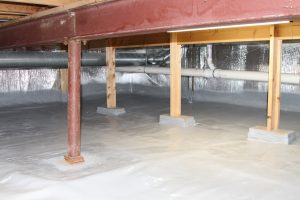While the average crawl space isn’t frequented very often, the presence of radon gas in it can be dangerous to your health. Your crawl space is connected to the rest of your home through unintentional gaps, cracks and openings. It is also connected to your home through plumbing lines, electrical and cable wires and ductwork. Through these connections, there is airflow exchange between your home and your crawl space. Here’s what our crawl space company in Indiana wants you to know about the potential danger of radon in your crawl space.
What is Radon?
Radon is a colorless, odorless gas that occurs naturally that is emitted from uranium deposits in the soil, rocks or water. It is naturally radioactive, and two radon atoms are released from every square centimeter of soil on Earth every second of every day. While the majority of radon is emitted into the atmosphere, humans may be at risk when we are inside.
Building Concentration
Crawl spaces and basements may help emit radon into our homes, and this is when it becomes dangerous. We breathe approximately 20 liters of air into our lungs each minute, meaning the average adult can accumulate 10,000 radioactive atoms every minute!
Protecting Your Home
You’ll need to ventilate your crawl space in order to keep radon levels healthy. You can also make sure there are no gaps that help radon seep into your home. If you see any gaps, you can use caulk or glue to shut them. Our crawl space company in Indiana is happy to install “radon draw points” using 4-inch PVC pipes coming from below the liner and sealed with polyurea spray. The pipe is then capped for future use if the passive system isn’t enough. In this case, we turn to a licensed mitigation company to help extract the gas.
Please call us today if you’re interested in our Nu-Crawl system, a permanent way to seal and insulate your crawl space.

